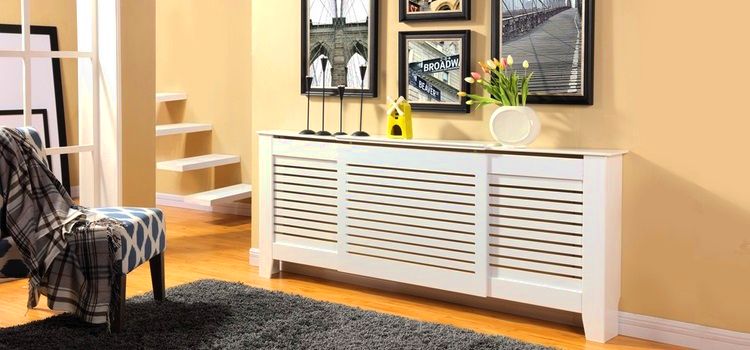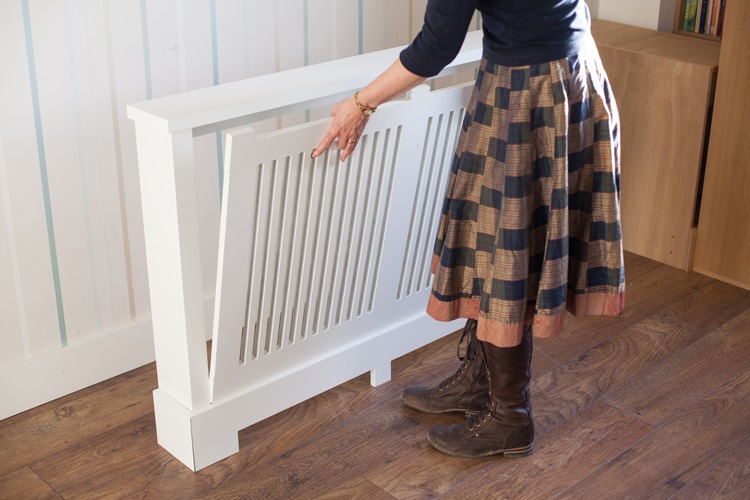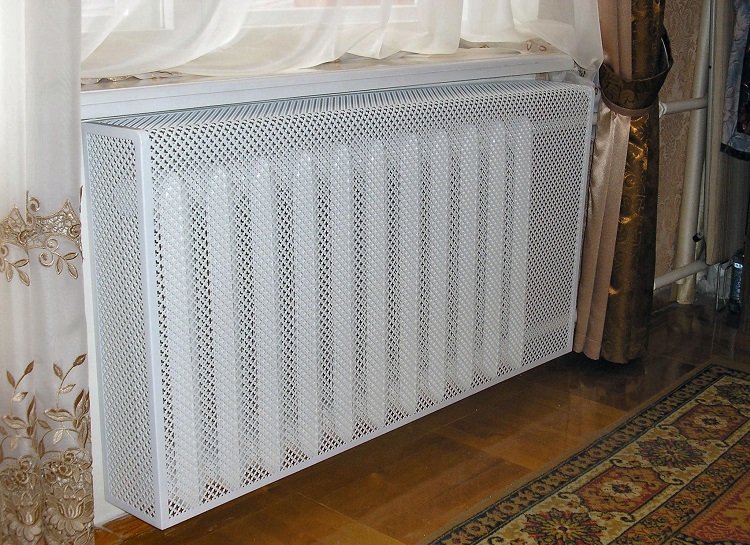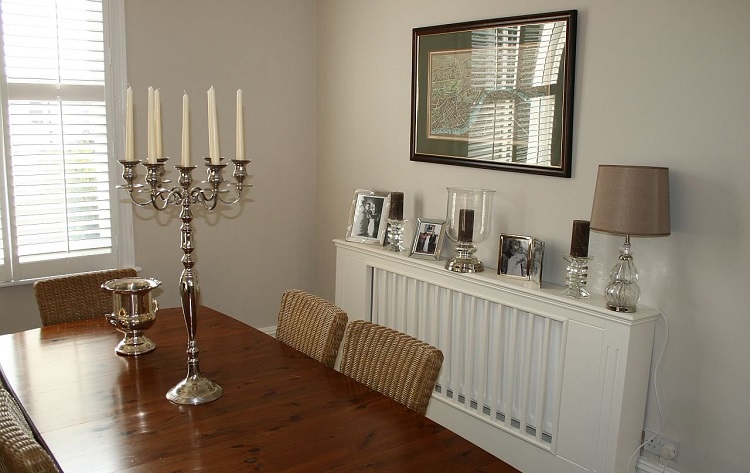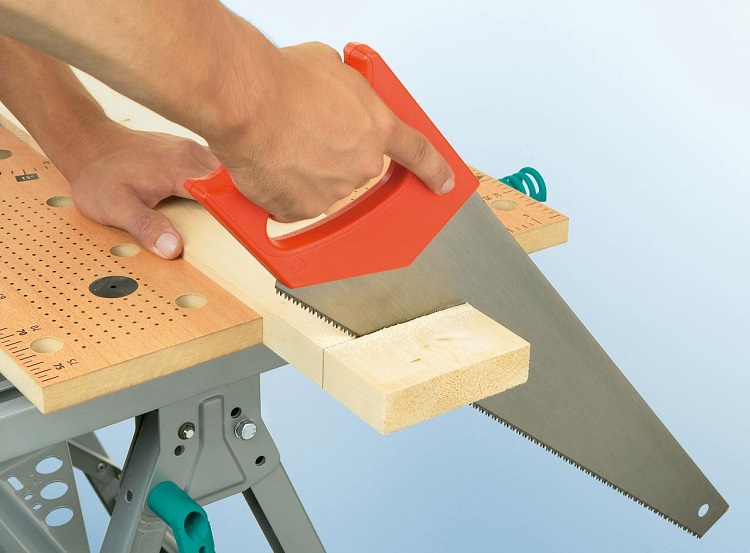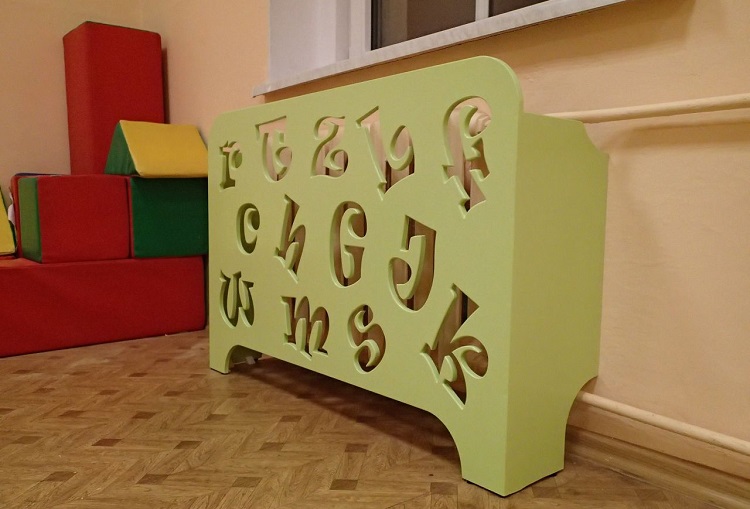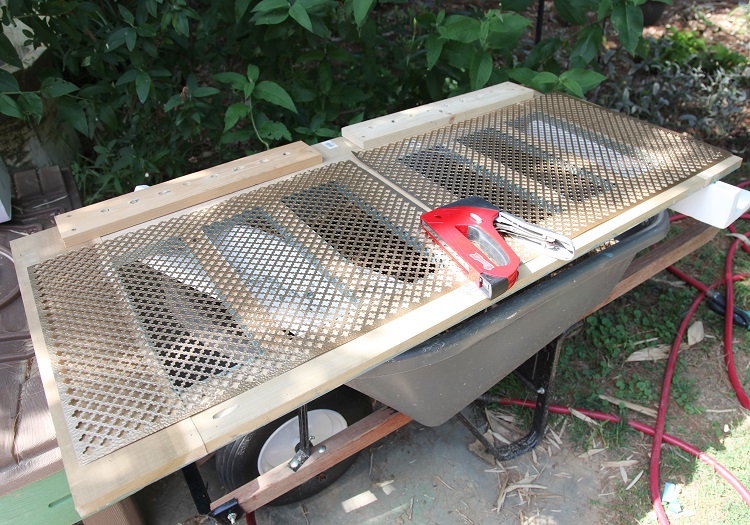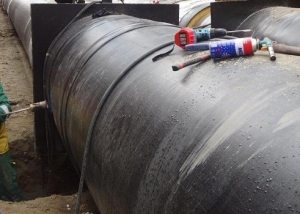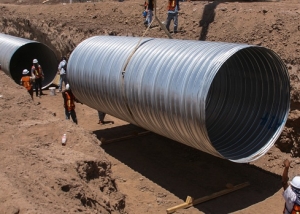Screens for radiators are designs that mask radiators. Often the batteries in the rooms do not fit into the overall interior, especially for cast-iron models, however, using a special screen allows you to cope with this problem. To date, there are many options for the manufacture of these structures, which can be purchased at any specialized store. Such a screen can be assembled independently. In this article we will look at how to make screens on the battery with your own hands.
Content
What should be the screen for the battery?
A heating radiator heats the room, radiating thermal energy and exchanging heat with air. The radiator screen must not interfere with normal room heating. This is the main parameter by which it is recommended to select a battery shutter.
Focusing on this parameter, we can highlight a list of rules that are recommended to be taken into account when making a screen for a battery with your own hands:
- The bottom surface of the screen should have a ventilation gap, which is necessary for free access of air. The width of such a space should be no less than 7 cm;
- The upper surface of the damper must also have a ventilation gap, which is necessary for the free exit of heated air. The width of such a gap should be no less than 10 cm;
- the distance from the extreme part of the damper to the front surface of the heater must be no less than 5 cm;
- perforation should occupy at least half of the total front surface area;
- the entire inner surface of the valve must be painted black;
- It is recommended to make the front panel of the screen removable, so that there is the possibility of quick access to the heating device;
- if the heater is equipped with thermostatic devices, then they should be located outside the screen.
Important! Behind the heater, a heat-reflecting screen must be installed. Such a measure is necessary in order to preserve thermal energy, which without a heat shield will heat the wall in the room.
Compliance with the above rules will make the screen for the battery as efficient as possible and eliminate possible problems during its operation.
Types of screens for batteries, depending on mounting option
Today, there are three main ways to install screens for heating appliances. Consider them:
- Hinged.
- Floor.
- Installed.
In the first case, the screen design is suspended by the battery or hung on special hooks pre-installed on the wall. The floor installation method of the screen structure implies its location on the floor. The screen in this case looks like a nightstand. The installed installation method is the most difficult, since the heater in this case is located inside the niche, and the damper itself is part of the overall surface of the wall and stands out only due to its decorative design.
The supporting elements of the panel for the heating battery can be made of different materials. It can be either a wooden beam or an aluminum corner. The design of the supporting structure depends on the materials of manufacture of the decorative damper. The perforated front panel is usually made of different materials. Consider them:
- Chipboard;
- Fiberboard;
- wooden slats;
- plywood;
- metal grid.
The installation method requires the use of steel profile parts or wooden bars for the supporting structure.
Functions Pros and cons of individual species
In addition to its main function (camouflage), screens for radiators perform other tasks. Let's consider these tasks in more detail:
- this design prevents the accumulation of dust in the sections of the heater;
- screens for heating radiators also perform a protective function, protecting children from possible injuries and burns;
- the shutter can serve as a shelf or a whole cabinet in which you can store various kitchen utensils;
- this design can be equipped with hooks and clothes to dry in the winter.
If you decide to make a screen for your heating battery with your own hands, then experts recommend using wood as a manufacturing material. Wood is the most convenient and easy to process material. Wooden screens are environmentally friendly and do not emit harmful substances that can harm human health.
Note! It is desirable to cover the wooden structure with protective compounds that will protect this material from deformation.
You can make a metal shutter yourself. However, making a metal screen for a battery with your own hands is more difficult. Designs are made of metal in the form of flaps or decorative lace. Differ in durability and high durability.
Particleboard, fiberboard are materials that are, although short-lived, but very easy to process. Details for the screen design can be cut from these materials even by eye, however, it is better for a pre-prepared stencil.
Plastic screens are not as popular as wooden ones. This is due to the fact that under the influence of high temperatures they emit substances harmful to human health.
Glass constructions are considered the most complex, from the point of view of doing it yourself, so they are bought ready-made. Such a damper can be designed as you like and is a stylish solution that can fit into any interior.
How to make a screen on a battery of wood?
As mentioned above, wood is considered the most popular material for the manufacture of decorative panels. The manufacture of wooden screens for batteries requires a minimum of labor costs, and the finished structure can be varnished, painted or painted on its surface. In any case, the wooden screen will have a presentable appearance. Consider how to make screens for batteries with your own hands from wood.
Specialists identify two main types of wood that are used to make such structures:
- oak;
- beech;
These materials are time-tested, reliable and durable. In this case, the perforated panel itself can be made of a battens.
The simplest screen on the heating battery is considered to be a wooden screen having a front panel of battens, girded around the perimeter with a wooden frame made of oak or beech. The location of the rails can be any and depends only on the desire of the owners.
Another variety of wooden dampers for heating devices is a special screen-blinds.This design, from a structural point of view, resembles wooden blinds that are installed on the windows. In order for the rails to be located at the same angle to the plane, it is necessary to make parallel cuts on the side racks. It is recommended to do two cuts, as the slats are usually twice as wide as a hacksaw on wood. All unnecessary is removed with a chisel.
One very important requirement is put forward for wood for the manufacture of the screen - the moisture coefficient of the material should not exceed 12%. Otherwise, proximity to the heater will lead to deformation of the wood. At home, checking the moisture level is quite simple: you need to take small chips and tie it into a knot. If the knot breaks, then the material is quite dry and can be used.
A regular screen and shutter in the form of blinds require the use of carefully polished rails. After fixing the slats to the wooden frame, it is necessary to priming them, as well as to coat these parts with varnish (preferably in 2 layers), paint or enamel.
You can make the screen from plywood. In order to make the front perforated panel from plywood, you will need a special tool - a jigsaw. Using it, cuts are made according to a pre-prepared stencil, so you can get a screen with any pattern.
Important! Particleboard and plywood have different characteristics and are divided into classes. To make a screen of these materials, you need to choose the appropriate class. For plywood, it should be E1, for chipboard - E0.
DIY metal screen on the battery
Metal screens for radiators are reliable and durable. Such designs are made of different metals. Products made of steel are equipped with an additional protective layer that is resistant to corrosion.
Making a metal screen for a heating battery with your own hands is more difficult than in the case of a wooden analog. However, a metal damper for a heating radiator has several advantages compared to a wooden one. The main advantage of this design is the high coefficient of thermal conductivity, which allows you to perform mounted models of screens that are fixed directly to the battery. This is a very convenient property.
This option for installing the screen is not only very convenient and does not require hooks in the wall, but also increases the working, heating surface of the heater. It is recommended to use an aluminum corner for the screen frame, and a sheet of the same material for the front panel. This is due to the fact that aluminum has a very high coefficient of thermal conductivity (5 times higher than that of steel).
Consider the phased assembly of such a screen on a do-it-yourself heating battery:
- First of all, you need to take two corners. Corners should be measured in advance and have a height equal to the future damper and the depth of the heater.
- Next, you need to perform 2 cuts on one of the walls of the first, and then the second corner. The cuts must be counter and form a right angle (90 °). These cuts are made so that the uncut walls of the products look at each other.
- At this stage, you need to bend the corners. The result should be two details in the form of the letter "G".
- Then you need to prepare the front perforated panel. For such a panel, you can use a perforated sheet or a perforated mesh. The length of such a panel should be measured in advance and correspond to the length of the corner.
- Next, you need to make three corners, which must have dimensions that correspond to the width of the shutter.
- At this stage, it is necessary to bend the damper blank and dock it with previously prepared corners in the shape of the letter “G”.To fix the workpiece, special screws or nuts with washers are used. The holes themselves are recommended not to be made in advance, but during the assembly process. This will allow to get into the perforation of the sheet.
- On the inside of the grid, you need to fix the three corners prepared previously. These products are fixed in the corner and around the edges and play the role of stiffening ribs.
- At the end, it is necessary to paint the outer surface of the corners in the form of the letter “G”.
The stability of such a screen can be increased by fixing it to the hooks in the wall, however, it should hold well on the battery. The choice of fixation depends on the individual preferences of the hosts.
